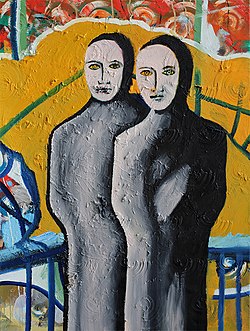
A Doppelgänger[1] is a look-alike or duplicate referring to two people that are not biologically related to each other. The term comes from the German words "doppel", meaning "double", and "ganger", meaning "going".
In folklore and literature, doppelgangers are often portrayed as bad luck or even evil creatures. However, in contemporary culture and scientific inquiry, the doppelganger phenomenon has generated interest due to its implications for genetics, psychology, and social interactions.
Research your ancestors on MyHeritage
Doppelgänger and Historical Context and FolkloreDoppelgänger and Historical Context and Folklore
Historically, the concept of a doppelgänger is common in mythologies and various literary works. In German folklore, the doppelganger is often seen as a harbinger of misfortune or death. Similar beliefs exist in other European cultures, as well as in parts of Asia and Africa.
Authors like Edgar Allan Poe, Fyodor Dostoevsky, and Robert Louis Stevenson have used the doppelganger motif to explore the dark corners of the human psyche. These works often explore the conflict between the conscious and unconscious mind, as well as the destructive power of the shadow self. One such famous literary example includes Edgar Allan Poe's short story "William Wilson", in which the protagonist is haunted by his doppelganger, who represents his conscience.
Some people believe that doppelgängers are actually ghostly manifestations of a person, representing their spiritual or astral double, while others view doppelgängers as individuals from parallel universes who have somehow crossed over into our reality.
While there's no scientific evidence to support these paranormal beliefs, they continue to fascinate and intrigue people all over the world.
Doppelgänger and GeneticsDoppelgänger and Genetics

While the concept might seem supernatural, scientific interest in doppelgängers has increased with advancements in genetics and facial recognition technology.
Facial features are complex traits influenced by multiple genes. These genes interact in intricate ways to shape the eyes, nose, mouth, and overall facial structure. While genetics provides important insights into the doppelgänger phenomenon, it is essential to recognize the limitations of our current understanding. Many genes that influence facial features remain unidentified, and the complex interplay between genes and environmental factors is still being explored. The genes responsible for facial structure are still being explored and we can expect to gain a deeper appreciation for the complex mechanisms that shape the human face and the fascinating phenomenon of doppelgängers.
A study into the doppelgänger phenomenon, attempting to understand it was done by Professor Tim Spector, a genetics researcher from North London. Prof. Spector decided to experiment, the first of its kind in the world in the scope and depth of the research, to test all aspects of the phenomenon. More about the experiment, it's details and its conclusions are detailed in the following blog: Doppelgänger – Twin Strangers.
Doppelgänger and Psychological EffectsDoppelgänger and Psychological Effects
Encountering a doppelgänger can be a profoundly unsettling experience for some people. The uncanny resemblance to another person (who is not genetically related) can trigger a range of psychological responses:
- Identity Crisis: One of the most intriguing aspects of encountering a doppelgänger is the potential for an identity crisis. Our sense of self is deeply intertwined with our physical appearance. When we meet someone who looks almost identical to us, it can challenge our fundamental understanding of who we are. Questions like "Am I unique?" or "What defines me?
- Disorientation and Confusion: Individuals who have struggled with their identity or self-esteem may be forced to confront their own insecurities and perceptions of themselves. The brain might struggle to reconcile the visual information with the concept of a separate individual.
- Existential Questions: Some people report experiencing deeper existential questions about life, fate, and the nature of reality after meeting a doppelgänger.
- Fear and Anxiety: In some cases, encountering a doppelgänger can evoke feelings of fear or anxiety, particularly if associated with cultural beliefs about doppelgänger as omens of misfortune.
Doppelgänger and Social MediaDoppelgänger and Social Media
In the digital age of 2024, social media platforms such as Instagram, Twitter and Facebook have increased the doppelgänger phenomenon presence in our lives through viral videos and shared photos, creating a buzz and false sense of glamour. Online platforms have made it easier for look-alikes to find each other, leading to the formation of doppelgänger communities. This increased visibility has sparked discussions about identity, genetics, and the nature of chance.
Doppelgänger and the Technological FutureDoppelgänger and the Technological Future
As technology continues to advance, the concept of doppelgängers is evolving. With the rise of "Deepfake" technology, it's becoming increasingly possible to create highly realistic digital replicas of people. These synthetic doppelgängers can be used for entertainment, but they also raise ethical concerns about identity theft, misinformation, and privacy.
The intersection of technology and the doppelgänger phenomenon is a rapidly developing field with the potential to reshape our understanding of identity, reality, and human connection.
Doppelgänger and the LawDoppelgänger and the Law
The increasing siting of doppelgängers, both in real life and the digital realm, raises intriguing legal questions.
- Identity Theft: With the rise of Deepfake technology, there's a growing concern about identity theft. Malicious actors could use synthetic doppelgängers to commit fraud or impersonate individuals for illegal purposes.
- Copyright and Intellectual Property: The creation of digital doppelgängers raises questions about ownership of one's likeness. Who owns the rights to a person's digital representation?
- Privacy Concerns: The collection and use of biometric data for creating doppelgängers can raise privacy concerns. How can individuals protect their personal information from being misused?
As technology continues to advance, the legal framework surrounding doppelgängers will need to catch up to address these challenges.
In ConclusionIn Conclusion
The doppelgänger phenomenon is a fascinating intersection of genetics, psychology and social dynamics. While folklore and literature have long captivated audiences with tales of mysterious doppelgängers, modern science offers insights into the genetic and psychological aspects of why some people look strikingly alike. As technology continues to develop, we hope that the investigation of this phenomenon will yield an even deeper understanding of human identity and social interaction.
Explore more about the Doppelgänger phenomenonExplore more about the Doppelgänger phenomenon
References
- ↑ doppelgänger. Merriam-Webster Dictionary

